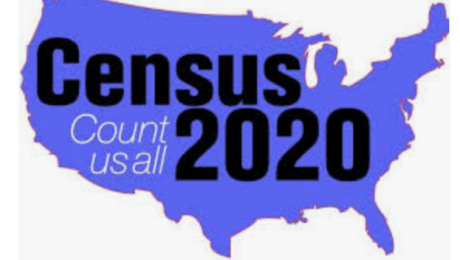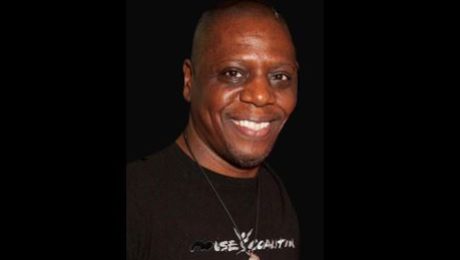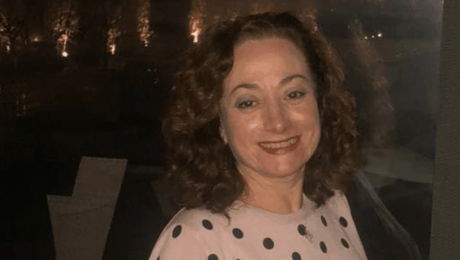Giving dance this season and the PERKS for our supporters!

The pandemic has affected us all and has made us appreciate the things we hold dear. That’s why we are dedicating this year’s #GivingTuesday on November 30, 2021 to our Teaching Artists that bring the gift of dance to schools and community centers. Won’t you join us in this global dav of giving?
Our 2021 theme Back To The Streets was chosen by the NYC Dance Community and celebrates our love of dance and our values of diversity, cultural equity and inclusion. We are scheduled to dance live on Broadway Saturday May 22nd, 2021 in the city’s largest dance event to showcase over 100 unique styles of dance.
In these past two years we overcame the challenges of dancing with the pandemic and delivered over 2500 youth and 300 adults with free classes online. Our programs funded teaching artists who danced with kids and older folks alike to support healthier, happier lives.
100% of your contribution will go to the artists and means so much to us and we are grateful for every tax-deductible donation, no matter how small!
HERE ARE THE PERKS WE OFFER FOR YOUR SUPPORT:
Friend of Dance: $20
- Participate in Dance Parade knowing you helped make the world’s large display of diverse cultures possible!
Dance Spirit: $50
- Your donation will be used where it is needed most.
- Recognition on our website as a Dance Spirit
- Get mailed a personal thank you letter from our director that includes a receipt letter for a 100% tax deductible donation
Mover & Shaker: $100
- All of the above and . . .
- Recognition on our website as a Mover & Shaker
- Get a commemorative “We Dance Together Again” refrigerator magnet
- Sponsor a Dance Organization of your choice in the 15th Annual Dance Parade May 22, 2021
Gifted Dancer: $150
- All of the above and . . .
- Recognition on our website as a Gifted Dancer
- Get a commemorative “We Dance Together Again Tote bag
- Get a signed photograph with the group you sponsor
Dance Angel: Donation level, $250 or more
- All of the above and . . .
- Recognition on our website as a Dance Angel
- Complimentary admission to the Dance Parade After Party
- Sponsor a Diversity Workshop in a New York City public school
- Get acknowledged by a personal Tweet and post to our Facebook Page
- View the parade as our guest in the Grandstand
How to donate:
Make check payable to “Dance Parade” and mail to:
455 FDR Drive, Suite B104, New York, NY 10002
Alternatively, use a credit card to contribute through our secure website here:
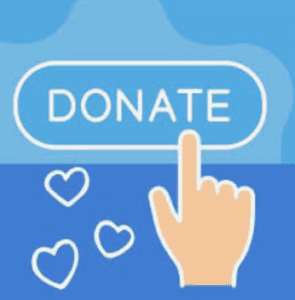
Thank you so much for your support!
Photo Credit: Joon Shin
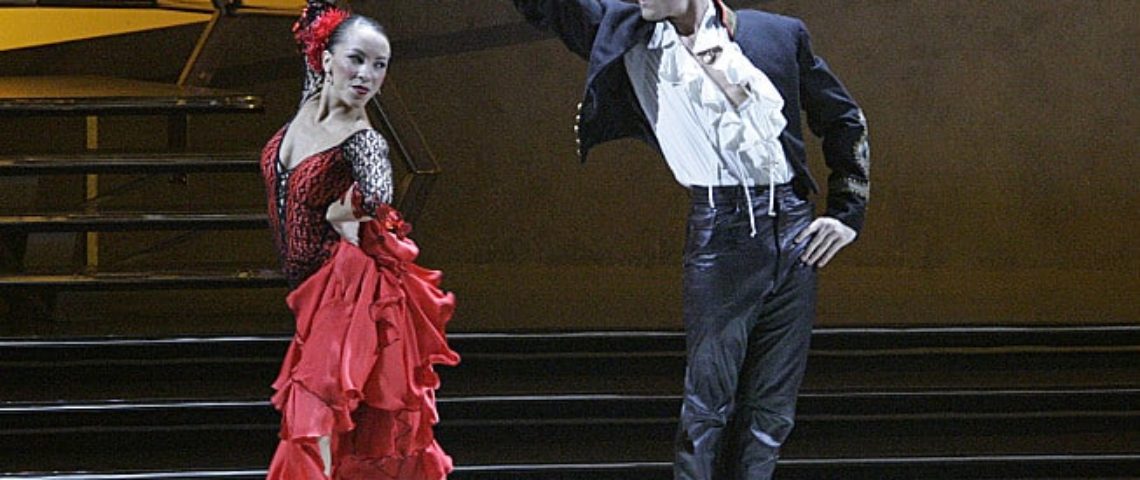
Genre Buzz: Pasodoble, a passionate Spanish ballroom dance!
- Published in 2020, Genre Buzz
Responding to the Census
Your Invitation To Respond
The time is now. Help shape your future, and your community’s future, by responding to the 2020 Census.
Most households received their invitation to respond to the 2020 Census between March 12 – 20. These official Census Bureau mailings will include detailed information and a Census ID for completing the Census online.
In addition to an invitation to respond, some households will receive a paper questionnaire (sometimes known as the census form). You do not need to wait for your paper questionnaire to respond to the Census.
The 2020 Census is for everyone.
Please complete your form online, by phone, or by mail when your invitation to respond arrives. Visit my2020census.gov to begin.
How To Respond
The 2020 Census will ask a few simple questions about you and everyone who is or will be living with you on April 1, 2020.
For the first time, you can choose to complete the census online, by phone, or by mail. Find out more about each of these methods below:
Please note that if you are responding online, you must complete the census in one sitting, as you don’t have the ability to save your progress. See the questions the census asks here.
If you do not receive an invitation to respond from the Census Bureau, you may respond online or visit our Contact Us page to call our phone line.
Who Should Respond
The 2020 Census counts everyone living in the United States and its five territories (Puerto Rico, American Samoa, the Commonwealth of the Northern Mariana Islands, Guam, and the U.S. Virgin Islands).
One person should respond for each home. That person must be at least 15 years old. They should live in the home or place of residence themselves and know general information about each person living there. (For more information, visit Questions Asked.)
Please note: If you live in American Samoa, the Commonwealth of the Northern Mariana Islands, Guam, or the U.S. Virgin Islands, the process for completing the census will be 100% paper-based and led by Census takers. Visit Counting the Island Areas for more information.
Everyone Counts
The Census Bureau has specific operations and processes in place to count everyone, including those in group living situations such as college dorms, nursing homes, military barracks, and prisons.
Who Should Be Counted and Where?
You should be counted where you are living and sleeping most of the time as of April 1, 2020. If you are responding for your home, count everyone who lives and sleeps there most of the time as of April 1, 2020. This includes young children, foster children, roommates, and any family members or friends who are living with you, even temporarily.
Please note that if someone is staying with you temporarily on April 1 due to the COVID-19 situation, they should be counted where they usually live. This includes college students, who should still be counted at school, even if they are home early because of the COVID-19 situation. If they live in student housing, the college will count them. If they live off campus, they should respond for the off-campus address and include any roommates or other people living there.
If someone is staying with you on April 1 who doesn’t have a usual home elsewhere, please include them in your response.
People in some living situations—including students, service members, and people in health care facilities—may have questions about how to respond or where they should count themselves. You may also have questions if you are moving, have multiple residences, or have no permanent address.
For more information, please visit Who to Count.
Language Support
You can complete the census online or by phone in 13 different languages: English, Spanish, Chinese, Vietnamese, Korean, Russian, Arabic, Tagalog, Polish, French, Haitian Creole, Portuguese, and Japanese.
In addition, bilingual invitations and paper questionnaires in English and Spanish will be sent to select areas of the country.
To help you respond, the Census Bureau also offers webpages and guides in 59 non-English languages, including American Sign Language, as well as guides in Braille and large print. Visit Language Support to learn more.
- Published in 2020
Team Spotlight: Meet Dori, latin dancer who’s coordinating the team!
In each issue of our STEPS! E-Newsletter we try to cast the Spotlight on one of our awesome team members to find out more about where they came from and to suss out their connection to dance and supporting the Dance Parade team. In this issue, we put the spotlight on Dori Garcia.
Hi Dori, Thanks for taking time out of your busy schedule to talk with us!
How did you first find out about Dance Parade?
I found out through my partner who was taking a Cuban Salsa Class with the organization’s director, Greg Miller.
What is your current role in Dance Parade New York?
I am the Team Coordinator and Project Manager. I basically work with all the committee chairs to place prospective team members. We are seeking over 200 this year so I’m looking forward to the challenge!
What is your favorite style of dance to watch? to participate in?
I love the latin dances. Tango is one of the most expressive dances I know and when I see it, I just get wowed!
What is your background or interest in dance?
I was raised in Alicante, Spain and have been practicing salsa on and off since I was five year’s old. I would go with my Aunti in Spain and do my own steps on the side. I also learned contemporary after school and now take bachata classes here in NYC.
If you could share the stage with anyone in history, famous or not, living or deceased, a trained dancer or not, performing a routine choreographed by yourself…who would it be?
I just absolutely love Ataca Y la Alemana, bachatta dancers.
Last year we celebrated the theme “Movement of the People” What does this year’s theme “Dance Without Borders ” mean to you?
I think Dance Without Borders demonstrates that it doesn’t matter where you come from or what your abilities/capabilities are—There are no limitations in order to dance and you can still share your passion to dance.
What dance group or dance style are you most looking forward to seeing this coming year in the parade?
I can’t wait to see the Cuban Rueda salsa. At the Dance Parade event “Winter’s Eve” at Columbus Circle, I saw Fuakata Cuban Ensemble choreographed and led by Chris Rojecki and they were just amazing.
If you could choose Grand Marshal for next year’s parade….who would it be?
I would love to see Shakira because she’s so passionate and helps others through her charity work.
If you could pick another country to hold a Dance Parade and Festival….which would it be?
Definetely Spain!
Working for a nonprofit organization can at times be daunting and frustrating with limited personnel and funding….what is it that keeps you coming back for more and more?
I had heard about Dance Parade before I came to New York and since I’m passionate about dance, it’s just amazing to me that I’m a part of an organization that allows us to express ourselves–and we do it in my favorite form–Dancing!
What pitch would you use to attract a new volunteer onto the Dance Parade team?
It’s a great opportunity to do something that makes a difference for so many people. And it’s a lot of fun and we put it all together in such a positive way—A lot of work but so worth it!
- Published in Uncategorized
TEAM SPOTLIGHT: Meet Ali Coleman!
In each issue of our STEPS! Newsletter we try to cast the Spotlight on one of our awesome team members to find out more about where they came from and to suss out their connection to dance and supporting the Dance Parade team. In this issue, we put the spotlight on Ali Coleman.
Hi, Ali. Thanks for taking time out of your busy schedule to talk with us.
What is your current role with Dance Parade?

My current role with Dance Parade is helping to coordinate Sponsorship. For me, I’ve been involved coordinating the House Coalition along with Luis Vargas for 14 years and consider Dance Parade as the Super Bowl of all my events each year! Having run an ad agency with a lot of nightlife industry contacts, I’m pyshced to join Dance Parade’s Steering Committee, many of whom I’ve known for years.
What are you up to when you’re not helping with Dance Parade?
I am a veteran NYC DJ, party organizer & promoter and Nightlife Advocate.
What is your favorite style of dance to watch? to participate in?
I Love to watch all styles of dance, but I would say that Pasodoble is my favorite to watch…such power in the movement! My favorite to participate in is ‘Freestyle’…no structure, just free movement.
Check out this video if you would like to know more about Pasodoble!
(sadly we didn’t catch Ali Coleman dancing to it..just yet!)
What is your dance background or interest in dance?
I’ve always been an avid dancer. I had my 1st dance performance on stage at the age of 5 in my elementary school’s talent show. For me dance is akin to breathing…without dance there is no life!
If you could share the stage with anyone in history famous or not, living or deceased, a trained dancer or not, performing a routine choreographed by yourself…who would it be?
The Nicholas Brothers, definitely!

Last year we honored immigrants and indiginous dance with “Movement of the People”. The year before, we celebrate the repeal of the Cabaret Law with the theme “The Cabaret of Life” — What does the 2020’s theme “Dance Without Borders ” mean to you?
Dance Without Boarders confirms what I’ve said for many years now.. I believe that anywhere we go on earth there is music and there are people dancing to that music.
What dance group or dance style are you most looking forward to seeing this coming year in the parade?
That’s a hard one….Dance Parade is like eating Sashimi…so many spectacular dance styles…impossible to pick just one

If you could choose a Grand Marshal for this year’s parade….who would it be?
Francois K.
If you could pick another country to hold a Dance Parade and Festival….which would it be?
Germany, Amsterdam…Japan would be phenomenal!!
Working for a non profit organization can at times be daunting and frustrating with limited personnel and funding….what is it that keeps you coming back for more and more?
Dance Parade encompasses everything that I believe at my core. It involves all cultures sharing in one of our most ancient communal activities! It’s one of my favorite days of the year!!
Describe a special memory you have from Dance Parades past?
One of my special memories is of the very 1st parade…I remember being very excited for that day to arrive, and didn’t even dance in the 1st parade. Instead I stood on the corner of 5th Ave between 8th street & Washington Square (north) to capture the parade on video!! Just thinking about it now has a big smile on my face!
What pitch would you use to attract a new volunteer onto the Dance Parade team?
Dance Parade is absolutely the most fun you’ll ever have working!!!

- Published in 2020, Team Spotlight, Volunteer Spotlight
The Collective Effervescence from dancing together!
There’s nowhere in the world where there is a culture that doesn’t move to music. This video presents research about the Collective Effervescence of dance and helps explain why there is so much joy in the air when 10,000 dancers come together in the Annual Dance Parade and Festival.
This video explains why dance has become a human necessity in the gluing of societies together:
 The French sociologist Émile Durkheim (1858-1917) theorised that ‘collective effervescence’ — moments in which people come together in some form of unifying, excitement-inducing activity — is at the root of what holds groups together. More recently, Dr. Bronwyn Tarr, an evolutionary biologist and psychologist at the University of Oxford who is also a trained dancer, has researched the evolutionary and neurological underpinnings of our innate tendency to bust a move.
The French sociologist Émile Durkheim (1858-1917) theorised that ‘collective effervescence’ — moments in which people come together in some form of unifying, excitement-inducing activity — is at the root of what holds groups together. More recently, Dr. Bronwyn Tarr, an evolutionary biologist and psychologist at the University of Oxford who is also a trained dancer, has researched the evolutionary and neurological underpinnings of our innate tendency to bust a move.
Photo credit: Miguel Chavez
Drawing on the work of both Durkheim and Tarr, this Aeon Original video explores that unifying feeling of group ‘electricity’ that lifts us up when we’re enthralled by our favourite sports teams, participating in religious rituals, entranced by music – and, yes, dancing together at the Annual Dance Parade New York.
You can read more about Durkheim and his work here and about Dr. Tarr’s work here.

The Annual Dance Parade, with over 100 unique forms of dance, is an accelerator of Collective Effervescence, gluing society together.
Photo credit: Glenmore-Marshall
One hypothesis is that it provides an opportunity for people to come together, making them move — dance — and in doing so we experience internal hormonal cascades which are made up of ‘feel good’ chemicals. These bursts of chemicals are part of our brain’s pain and pleasure and reward circuitry, and when they are triggered they provide an experience of elation and positive reward. When we get this kick in the presence of others, the result is that of collective joy — positive, shared experiences through which we establish and maintain important social connections with others. Now we feel like we belong to a unified, cohesive whole.
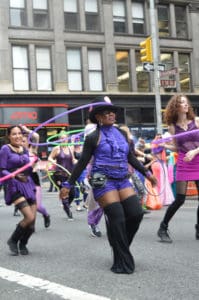
Being part of a cohesive social group would have been really important for our ancestors — collaborating with others to find shelter, hunt, rear young would have increased our chances of survival. Music and dance are by no means the only ways we can stimulate these positive social ‘highs’. But they’re really good ways of doing it because it’s an experience that we can share with lots of people at once. In order to understand why that would have given us such a great advantage we need to look at our species in the context of primates.
Photo Credit: Chris Fernando
Get Social with Dance Parade on:
Facebook
Instagram
YouTube
Learn more about our friends at Aeon
- Published in 2019
Team Spotlight: Meet Rebecca, a long-time East Village resident with a flair for Publicity!
In each issue of our STEPS! Newsletter we try to cast the Spotlight on one of our awesome team members to find out more about where they came from and to suss out their connection to dance and supporting the Dance Parade team. In this issue, we put the spotlight on Rebecca Myles.
Hi, Rebecca. Thanks for taking time out of your busy schedule to talk with us.
How did you first find out about Dance Parade?
I first came across DanceFest as it’s held in Tompkins Square Park and I live close by. Performing on stage was a salsa group where this rather senior dancer suddenly flipped his partner upwards and twirled her around his neck. My mouth dropped open in wonder and then admiration at his skill and stamina. I was riveted to the spot, wondering “what is this?” and got hooked into Dance Parade.
What is your current role in Dance Parade New York?
Head of Publicity. We aim to make sure as many New Yorkers know about the parade through listings and pre-parade interviews and coverage, and then on the day coverage.
Every year we host a press conference at City Hall during the week leading up to the parade. The upcoming one is Wednesday May 15th at 2pm. We will receive a Proclamation from the City which declares the coming Saturday as Dance Parade Day. It is a charming tradition and the Proclamation is beautiful. I am always intrigued by the inventive ways the Mayor describes the Parade and DanceFest.
The New York press are very generous to us and we’ve been featured over the years on NY1, New York Times, New York Daily News, New York Post, Wall Street Journal, New Yorker, Time Out, Gothamist, AMNY, The Villager, 1010 WINS, WABC, WBAI, Univision, to name but a few.
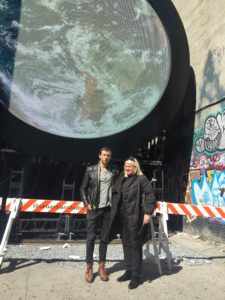
What is your favorite style of dance to watch? to participate in?
I love watching all kinds of dance because it transports me to a heartfelt space for experiencing an emotional “movement” story. Most recently I attended a lecture by Catherine Turocy, Director of New York Baroque Dance, which included demonstrations of Baroque dance styles. It was exquisite and what struck me was the intimacy of couples dancing and the inevitable poetry of two bodies in motion knitted by hand and eye touches. The evening was organized by NYU’s La Maison Francaise.
The last dancing I did was on Jeannie Hoppers’ Liquid Sound Lounge “Disco” boat. She has another name for it but that’s how I encourage friends to come. My friend Jenny always turns up as she understands the sheer brilliance of dancing on the East River against a backdrop of a New York skyline with Jeannie on the turntables, and live musicians.
What is your dance background or interest in dance?
I remember wanting to do ballet as a kid but that didn’t happen. I suspect there was no extra cash. I had lots of excess energy even after climbing trees and biking everywhere so perhaps I saw dance as a channel, a home. I did ballroom dancing in college, and always went clubbing. I loved the free jazz dance floor downstairs at the Rock City in Nottingham. When I got to New York it was off to Nell’s, the Bank, Palladium, Robots…and for a while I took dance lessons in swing, African…but with pairing dances too often I land in trouble wanting to lead all the time.
If you could share the stage with anyone in history famous or not, living or deceased, a trained dancer or not, performing a routine choreographed by yourself…who would it be?
Bob Fosse – because he understood the erotic and ascendant power dance.
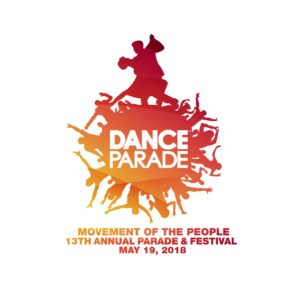
Last year we celebrated the repeal of the Cabaret Law with the theme “The Cabaret of Life” — What does this year’s theme “Movement of the People ” mean to you?
It is a potent theme in the 21st Century because it rests with us, the people, to wrest back our power to shape the world we want – fairness to people who need help, economic policies that support all our lives on earth with the other inhabitants, and thoughtful inclusive policies for education and healthcare.

What dance group or dance style are you most looking forward to seeing this coming year in the parade?
The Native American Circle Dance that will open the parade reclaiming Mannahatta for the Lenape peoples. Dance, prayer, true thoughtful beauty – can’t beat that.
If you could choose a Grand Marshal for this year’s parade….who would it be?
Michelle Obama has done so much to address physical fitness with her Let’s Move Initiative when she was First Lady. Just check out this video with the So You Think You Can Dance All Stars! (as Rebecca whips up this video on her phone…)
If you could pick another country to hold a Dance Parade and Festival….which would it be?
Most certainly another country, one with deep rooted culture like Mexico or India — It would be fun to share other world cultures with them.
Working for a non profit organization can at times be daunting and frustrating with limited personnel and funding….what is it that keeps you coming back for more and more?
It’s family. There are the regulars and it is great to work with the team each year and see our family of photographers turn up on Parade Day. But I’ve noticed that all the new volunteers all have a special magic that makes them fit right in and feel like we’ve known the all along. Then it’s those enthusiastic, brilliant dancers – movement artists – who are all sublime!
- Published in 2018, Team Spotlight
Dance Parade welcomes Disney’s Aladdin to the Dance Parade!
Dance Parade is excited to welcome Disney’s Aladdin to the Dance Parade!
The movie will be released May 24th and is a a thrilling and vibrant live-action adaptation of Disney’s animated classic, “Aladdin”– an exciting tale of the charming street rat Aladdin, the courageous and self-determined Princess Jasmine and the Genie who may be the key to their future.
Directed by Guy Ritchie (“Sherlock Holmes,” “The Man from U.N.C.L.E.”), who brings his singular flair for fast-paced, visceral action to the fictitious port city of Agrabah, “Aladdin” is written by John August (“Dark Shadows,” “Big Fish”) and Ritchie based on Disney’s “Aladdin.”
The film stars Will Smith (“Ali,” “Men in Black”) as the larger-than-life Genie; Mena Massoud (“Tom Clancy’s Jack Ryan”) as the charming scoundrel Aladdin; Naomi Scott (“Power Rangers”) as Jasmine, the beautiful, self-determined princess; Marwan Kenzari (“Murder on the Orient Express”) as Jafar, the powerful sorcerer; Navid Negahban (“Legion”) as the Sultan concerned with his daughter’s future; Nasim Pedrad (“Saturday Night Live”) as Dalia, Princess Jasmine’s free-spirited best friend and confidante; Billy Magnussen (“Into the Woods”) as the handsome and arrogant suitor Prince Anders; and Numan Acar (“The Great Wall”) as Hakim, Jafar’s right-hand man and captain of the palace guards.

Naomi Scott as Jasmine and Mena Massoud as Aladdin in Disney’s live-action adaptation of ALADDIN, directed by Guy Ritchie.
Eight-time Academy Award®-winning composer Alan Menken (“Beauty and the Beast,” “The Little Mermaid”) provides the score, which includes new recordings of the original songs written by Menken and Oscar-winning lyricists Howard Ashman (“Little Shop of Horrors”) and Tim Rice (“The Lion King”) and includes two new songs written by Menken and Oscar and Tony Award®-winning songwriters Benj Pasek and Justin Paul (“La La Land,” “Dear Evan Hansen”).

Aladdin (Mena Massoud) meets the larger-than-life blue Genie (Will Smith) in Disney’s live-action adaptation ALADDIN, directed by Guy Ritchie.

Mena Massoud as the street rat with a heart of gold, Aladdin, and Will Smith as the larger-than-life Genie in Disney’s ALADDIN, directed by Guy Ritchie.
Share on Social Media:
Hashtag: #Aladdin
- Published in Uncategorized
Volunteer Spotlight: Meet Mona Freeman
In each issue of our STEPS! Newsletter we try to cast the Spotlight on one of our awesome team members to find out more about where they came from and to suss out their connection to dance and supporting the Dance Parade team. In this issue, we put the spotlight on Mona Freeman.
Hi, Mona. Thanks for taking time out of your busy schedule to talk with us.
How did you first find out about Dance Parade?
 I saw a posting on LinkedIN last year and was intrigued by the idea of a dance parade.
I saw a posting on LinkedIN last year and was intrigued by the idea of a dance parade.
I love to create, direct and produce crowd pleasing entertainment and this seemed like a good match.
I sent a connection request to Greg Miller, the Executive Director of the nonprofit that produces Dance Parade, stating that I wanted to know more about the Dance Parade. However, I was not able to be a part of it in 2018.
This season, when the volunteer committee was looking for people to join, I answered the call!

What is your current role in Dance Parade New York?
I am on the Curation Committee, planning the Dance Festival which will take place in Tompkins Square Park following the parade. I am currently watching through videos of dance performances to decide where they will be placed in the festival. I will then be coordinating the groups who will be presented on the family stage. The family stage will be presenting most of the groups that are made up of youngsters. I have previously presented dozens of performances with a cast of hundreds of children as young as three years old through teens.
What is your favorite style of dance to watch? to participate in?
Musical Theater and Ballet. When I began my dance training, I was influenced by the Broadway show A Chorus Line and the movie The Turning Point. I’ve studied numerous forms of dance, but ballet is what keeps me coming back because there is always something new to achieve.
What is your dance background or interest in dance?
My first formal dance lesson was at the age of thirteen. I was a high school gymnast and joined a ballet class in order to supplement my skills. I soon realized that I enjoyed ballet far more than gymnastics. I studied Dance Education at New York University and established a private dance studio shortly after graduation. I directed and taught students three years old through adults in Ballet, Tap, Jazz for over three decades.
If you could share the stage with anyone in history famous or not, living or deceased, a trained dancer or not, performing a routine choreographed by yourself…who would it be?
Gene Kelly, he made it look effortless. I would dance with him in the ballet presented at the end of An American In Paris. It’s a classic and doesn’t need any improvement.

Last year we celebrated the repeal of the Cabaret Law with the theme “The Cabaret of Life” — What does this year’s theme “Movement of the People ” mean to you?
Dance has been a means of expression since the beginning of time. For some people it is a cultural experience, for others it is a social experience, and there are those who bring dance to the stage for artistic expression or purely to entertain. With Dance Parade New York, we celebrate all of these dancers.
What dance group or dance style are you most looking forward to seeing this coming year in the parade?

I am looking forward to seeing the community engagement groups who will be performing on the family stage. With these programs in schools and community centers throughout NYC, these youngsters and senior citizens have been exposed to something new. They learn tangible skills in movement and expression as well as intangible ones like confidence and team building. The final project of being in the parade and festival brings all this together. Some of them may be involved in dancing for the first time, or possibly since a long time ago. This is a wonderful experience for them, I want to share their joy!
If you could choose a Grand Marshal for this year’s parade….who would it be?
I would choose Rhee Gold. He is a source of motivation and encouragement for dance teachers and studio owners in the private sector. Rhee’s mother was a dance teacher. Rhee and his twin brother Rennie grew up in that world. Thousands of students attend dance classes each week where they not only learn dance technique, they learn life’s lessons.
Working for a non profit organization can at times be daunting and frustrating with limited personnel and funding….what is it that keeps you coming back for more and more?
When you are working on something that has personal meaning for you, the struggle is worth the trouble. I support the mission of Dance Parade: to promote dance as an expressive and unifying art form by showcasing all forms of dance, educating the general public about the opportunities to experience dance, and celebrating diversity of dance in New York City by sponsoring a yearly city-wide dance parade and dance festival.
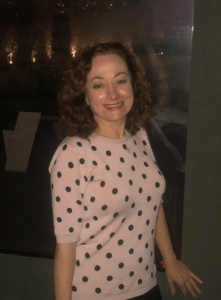
What pitch would you use to attract a new volunteer onto the Dance Parade team?
If you love dance and the unbridled freedom of dancing in the streets, you need to join us!
Thanks Mona–Folks who want to volunteer can click here to fill out our short form!
- Published in 2019, Team Spotlight, Volunteer Spotlight
Genre Buzz: Circle Dance, to start the 2019 Parade!
Circle dance is a style of dance done in a circle or semicircle to musical accompaniment, such as rhythm instruments and singing. Circle dancing is probably the oldest known dance formation and was part of community life from when people first started to dance.
Dancing in a circle is an ancient tradition common to many cultures for marking special occasions, rituals, strengthening community and encouraging togetherness. The dance can also be enjoyed as an uplifting group experience or as part of a meditation. Circle dances are choreographed to many different styles of music and rhythms.
Unlike line dancing, circle dancers are in physical contact with each other; the connection is made by hand-to-hand, finger-to-finger or hands-on-shoulders. It is a type of dance where anyone can join in without the need of partners. Generally, the participants follow a leader around the dance floor while holding the hand of the dancers beside them. The dance can be gentle or energetic.
Modern circle dance mixes traditional folk dances, mainly from European or Near Eastern sources, with recently choreographed ones to a variety of music both ancient and modern. There is also a growing repertoire of new circle dances to classical music and contemporary songs.
Culture
Modern circle dancing is found in many cultures, including Arabic (Lebanese and Iraqi), Israeli (see Jewish dance and Israeli folk dancing), Assyrian, Kurdish, Turkish, Armenian, Azerbaijani, Maltese, and South Eastern European (i.e. Albanian, Bosnian, Bulgarian, Croatian, Greek and Serbian, to name a few).
Despite its immense reputation in the Middle East and southeast Europe, circle dancing also has a historical prominence in Brittany, Catalonia and Ireland to the west of Europe, and also in South America (Peruvian), Tibet, and with Native Americans (see ghost dance). It is also used, in its more meditative form, in worship within various religious traditions including, the Church of England and the Islamic Haḍra dances.
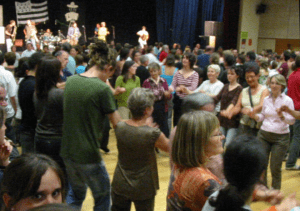 Western Europe: An-Dro
Western Europe: An-Dro
An Dro, meaning “the turn”, is a Breton circle dance. The dancers link the little fingers in a long line, swinging their arms, whilst moving to their left. The arm movements consist first of two circular motions going up and back followed by one in the opposite direction. The leader (person at the left-hand end of the line) will lead the line into a spiral or double it back on itself to form patterns on the dance floor, and allow the dancers to see each other.
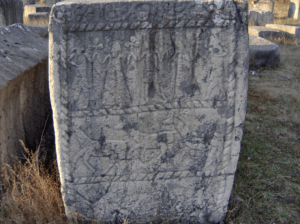 Thousands of medieval tombstones called “Stecci” were found in Bosnia and Hercegovina and neighboring areas. They dated from the end of the 12th century to the 16th century. They bear inscription and figures which look like dancers in a chain. Men and women are portrayed dancing together holding hands at shoulder level but occasionally the groups consist of only one sex.[4][5]
Thousands of medieval tombstones called “Stecci” were found in Bosnia and Hercegovina and neighboring areas. They dated from the end of the 12th century to the 16th century. They bear inscription and figures which look like dancers in a chain. Men and women are portrayed dancing together holding hands at shoulder level but occasionally the groups consist of only one sex.[4][5]
In Macedonia near the town of Zletovo, the murals on the monastery of Lesnovo (Lesnovo Manastir), which date from the 14th century, show a group of young men linking arms in a round dance. A chronicle from 1344 urges the people of the city of Zadar to sing and dance circle dances for a festival. However, a reference comes from Bulgaria in a manuscript of a 14th-century sermon, which calls chain dances “devilish and damned.”
 The hora dance originates in the Balkans but also found in other countries (including Romania and Moldova). The dancers hold each other’s hands and the circle spins, usually counterclockwise, as each participant follows a sequence of three steps forward and one step back. The Hora is popular during wedding celebrations and festivals, and is an essential part of the social entertainment in rural areas. In Bulgaria, it is not necessary to be in a circle; a curving line of people is also acceptable.[22]
The hora dance originates in the Balkans but also found in other countries (including Romania and Moldova). The dancers hold each other’s hands and the circle spins, usually counterclockwise, as each participant follows a sequence of three steps forward and one step back. The Hora is popular during wedding celebrations and festivals, and is an essential part of the social entertainment in rural areas. In Bulgaria, it is not necessary to be in a circle; a curving line of people is also acceptable.[22]Kolo
The kolo is a collective folk dance common in various South Slavic regions, such as Serbia, named after the circle formed by the dancers. It is performed amongst groups of people (usually several dozen, at the very least three) holding each other’s having their hands around each other’s waists (ideally in a circle, hence the name). There is almost no movement above the waist.
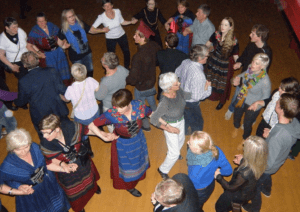 Faroese dance
Faroese dance
The Faroese dance is the national circle dance of the Faroe Islands. The dance originated from the medieval times, which survived only in the Faroe Islands, while in other European countries it was banned by the church, due to its pagan origin. The dance is danced traditionally in a circle, but when a lot of people take part in the dance they usually let it swing around in various wobbles within the circle. The dance in itself only consists in holding each other’s hands, while the dancers form a circle, dancing two steps to the left and one to the right wirhout crossing the legs. When more and more dancers join the dance ring, the circle starts to bend and forms a new one within itself.
Sacred Circle Dance
The Sacred Circle Dance was brought to the Findhorn Foundation community in Scotland by Bernhard Wosien who brought traditional circle dances that he had gathered from across Eastern Europe.
Colin Harrison and David Roberts took the dances to other parts of the UK where they started regular groups in south east England and Somerset, then across Europe, the US and elsewhere. The network extends also to Australia, New Zealand, South Africa and South America and India.
A small centrepiece of flowers or other objects is often placed at the centre of the circle to help focus the dancers and maintain the circular shape. Much debate goes on within the sacred circle dance network about what is meant by ‘sacred’ in the dance.
Dabke
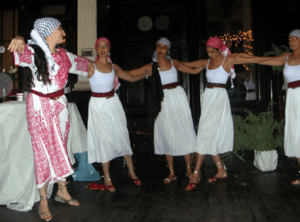 Dabke is popular in Lebanon, Syria, Palestin, Israel, Jordan and Turkey. The most famous type of the dance is the Al-Shamaliyya (الشمالية). It consists of a lawweeh (لويح) at the head of a group of men holding hands and formed in a semicircle. The lawweeh is expected to be particularly skilled in accuracy, ability to improvise, and quickness (generally light on his feet). The dancers develop a synchronized movement and step, and when the singers finish their song the lawweeh breaks from the semicircle to dance on their own. The lawweeh is the most popular and familiar form of dabke danced for happy family celebrations.
Dabke is popular in Lebanon, Syria, Palestin, Israel, Jordan and Turkey. The most famous type of the dance is the Al-Shamaliyya (الشمالية). It consists of a lawweeh (لويح) at the head of a group of men holding hands and formed in a semicircle. The lawweeh is expected to be particularly skilled in accuracy, ability to improvise, and quickness (generally light on his feet). The dancers develop a synchronized movement and step, and when the singers finish their song the lawweeh breaks from the semicircle to dance on their own. The lawweeh is the most popular and familiar form of dabke danced for happy family celebrations.
Ganggangsullae (강강술래)
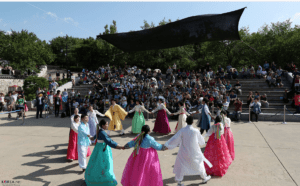
Ganggangsullae is an ancient Korean dance that was first used to bring about a bountiful harvest and has developed into a cultural symbol for Korea. It incorporates singing, dancing, and playing and is exclusively performed by women. The dance is mostly performed in the southwestern coastal province of Jeollanam-do. It is often associated with the Chuseok holiday and Daeboreum.
The next time you see a Circle Dance, join in — It’s fun and you will be participating in an ancient cultural tradition!
Article Source: Wikipedia (English version)
- Published in 2019, Genre Buzz


